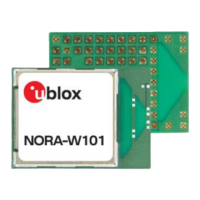*About 45 kΩ.
Table 3: NORA-W10 series boot strapping pins
Pin F7 is used to enter the ESP bootloader. Consequently, this pin must be exposed on a pin header
(or similar) to flash the module. To enter bootloader mode, hold down the Boot pin F7 during the power
on. To enter the programming mode, assert a reset in bootloader mode. See Figure 4.
Figure 4: Button on Boot pin
2.6 Antenna integration
Antenna interfaces are different for each module variant in the NORA-W10 series. The modules
support either an internal antenna (NORA-W106) or external antennas connected through a
dedicated antenna pin (NORA-W101).
2.6.1 External RF antenna interface
NORA-W101 is equipped with an antenna signal (ANT) pin. The pin has a nominal characteristic
impedance of 50 and must be connected to the antenna through a 50 transmission line.
Choose an antenna with optimal radiating characteristics for the best electrical performance and
overall module functionality. An internal antenna, integrated on the application board or an external
antenna connected to the application board through a proper 50 connector, can be used.
When using an external antenna, the PCB-to-RF-cable transition must be implemented using either
a suitable 50 connector, or an RF-signal solder pad (including GND) that is optimized for 50
characteristic impedance.

